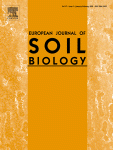Ver ítem
- xmlui.general.dspace_homeCentros e Institutos de InvestigaciónCIAP. Centro de Investigaciones AgropecuariasInstituto de Patología VegetalArtículos científicosxmlui.ArtifactBrowser.ItemViewer.trail
- Inicio
- Centros e Institutos de Investigación
- CIAP. Centro de Investigaciones Agropecuarias
- Instituto de Patología Vegetal
- Artículos científicos
- Ver ítem
Response of soil microbial communities to different management practices in surface soils of a soybean agroecosystem in Argentina
Resumen
Argentina is the world’s third most important soybean producer; hence, there is an urgent need to preserve soil health by applying appropriate agricultural practices to maintain sustainable production in the upcoming years. Because productivity of agricultural systems largely depends on soil microbial processes, the influence of different management strategies on soil microbial community structure was analyzed in a long-term field trial started in 1992.
[ver mas...]
Argentina is the world’s third most important soybean producer; hence, there is an urgent need to preserve soil health by applying appropriate agricultural practices to maintain sustainable production in the upcoming years. Because productivity of agricultural systems largely depends on soil microbial processes, the influence of different management strategies on soil microbial community structure was analyzed in a long-term field trial started in 1992. The experimental design was a split-plot arrangement of treatments, consisting in two tillage treatments: zero tillage (ZT) and reduced tillage (RT), in combination with two crop rotation treatments: soybean monoculture (SS) and corn-soybean (CS). Phospholipid fatty acid (PLFA) profiles were used to assess total microbial community structure. Denaturing gradient gel electrophoresis (DGGE) profiles of 18S rRNA were generated to describe the influence of crop practices on fungal communities. Total PLFA content was lowest in soil under reduced tillage and soybean monoculture; therefore the use of reduced tillage-soybean monoculture in agroecosystems might produce important reductions in total microbial biomass. The structure of total microbial communities, as estimated by PLFA, was affected by crop rotation. Moreover, the fungal communities, as estimated by DGGE analysis, were influenced by combined effects of crop rotation and tillage system.
[Cerrar]

Autor
Vargas Gil, Silvina;
Meriles, José Manuel;
Conforto, Erica Cinthia;
Basanta, Maria;
Radl, V.;
Hagn, A.;
Schloter, M.;
March, Guillermo Juan;
Fuente
European Journal of Soil Biology 47 (1) : 55-60 (January–February 2011)
Fecha
2010-12-03
Editorial
Elsevier
ISSN
1164-5563
Formato
pdf
Tipo de documento
artículo
Palabras Claves
Derechos de acceso
Restringido
 Excepto donde se diga explicitamente, este item se publica bajo la siguiente descripción: Creative Commons Attribution-NonCommercial-ShareAlike 2.5 Unported (CC BY-NC-SA 2.5)
Excepto donde se diga explicitamente, este item se publica bajo la siguiente descripción: Creative Commons Attribution-NonCommercial-ShareAlike 2.5 Unported (CC BY-NC-SA 2.5)

